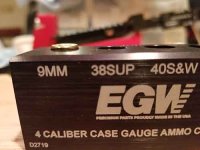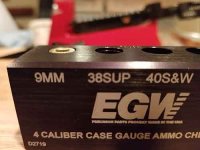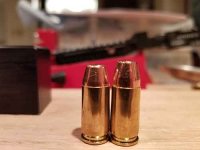I'm having a problem with these rounds sticking in the chamber checker and my MP barrel.
https://www.berrysmfg.com/product/bp-9mm-356-124gr-fp
I'ts a flat nose 124gr berry's plated bullet. The round nose work fine. But these don't seat as low in the chamber checker and I need to give it a good tap to get them out.
I'm seating to the berrye's spec 1.060 COAL. These bullets are .356 not .355. I wonder if that is part of the problem or the flat nose profile. Seems ogive is contacting the stepped down portion of the chamber checker and chamber.
Resized cases plunk in and out no problem. I'm using the Lyman M expander die and hornady seating die with lee resize and FCD. It seems they work a bit better with no crimp at all.
I don't know if going shorter than 1.06 would be ok or safe (regarding pressure) or make a difference. Any ideas?
https://www.berrysmfg.com/product/bp-9mm-356-124gr-fp
I'ts a flat nose 124gr berry's plated bullet. The round nose work fine. But these don't seat as low in the chamber checker and I need to give it a good tap to get them out.
I'm seating to the berrye's spec 1.060 COAL. These bullets are .356 not .355. I wonder if that is part of the problem or the flat nose profile. Seems ogive is contacting the stepped down portion of the chamber checker and chamber.
Resized cases plunk in and out no problem. I'm using the Lyman M expander die and hornady seating die with lee resize and FCD. It seems they work a bit better with no crimp at all.
I don't know if going shorter than 1.06 would be ok or safe (regarding pressure) or make a difference. Any ideas?



